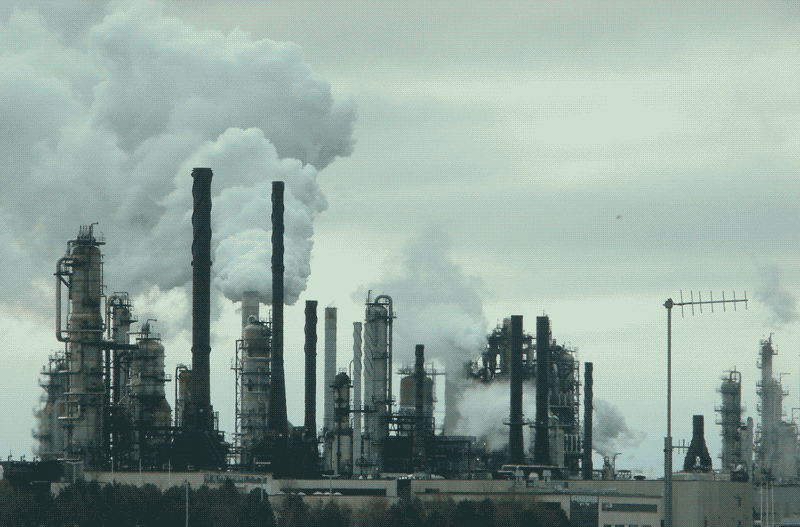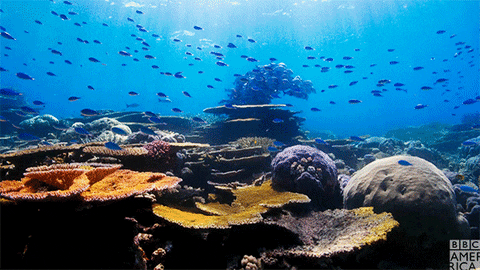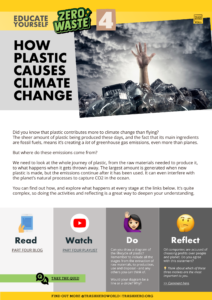Plastic isn’t just a pollution and public health problem; it’s the fastest growing industrial source of greenhouse gas emissions on the planet!
Yikes. It’s true: the production, use and disposal of plastics are now estimated to contribute up to 8% of global greenhouse gas emissions each year, compared with the whole aviation industry (estimated at around 3.5% of emissions). This doesn’t mean it’s okay to take the plane when there’s an alternative option! It’s just to give you an idea of the scale of the problem.
But how is that amount of emissions even possible? By now, we know plastic is made of fossil fuels + chemicals. In the 1950s, when it first came into wider use, plastic accounted for less than 1% of global oil consumption. These days it uses around 7% and this is projected to increase to 20% by 2050. This is because big oil companies believe making more plastic will save their profits as the world moves away from fossil fuels to towards renewable sources of energy.

To understand the climate impacts of plastic though, we don’t just look at its ingredients. We need to consider its whole journey, from how it’s made to what happens after it’s thrown away – a.k.a. its lifecycle. This gives us a much fuller picture.
Let’s break down the hidden emissions during the lifecycle of plastic.
EMISSIONS FROM EXTRACTION & PRODUCTION
Plastic’s journey begins with the extraction of fossil fuels from the Earth, which emits greenhouse gases like carbon dioxide and methane. The refining and manufacturing processes (the cracking and polymerisation we learned about in Part 1) then release more CO2 and other pollutants into the atmosphere. Around 90% of the greenhouse gas emissions associated with plastic are created at this production stage.

Plastic is also transported at every stage of its life and this uses more fossil fuels.
EMISSIONS FROM DISPOSAL
The endless stream of plastic packages and products we deal with every day will usually end up either in a landfill or incinerated. A small amount gets recycled. And a lot of plastic also gets into the environment – there’s more about that below.
Landfilling plastic, especially when mixed up with food waste and other organic material, creates conditions where methane is produced. Methane – which you may know from cow farts – is a greenhouse gas that’s way better than CO2 at trapping heat in the atmosphere. It makes climate change happen at a much faster rate.
Landfills are the world’s third largest source of methane emissions (cows and other agriculture come in – appropriately – at no. 2, with energy production taking the top spot). Making sure food waste doesn’t end up with plastic and other non-organic material in the landfill would reduce this a lot.

Incinerating plastic is a big problem. As it’s made from fossil fuels, it has the same climate impacts as burning oil and gas, with added toxic chemicals being released – often near where people live.
A small amount of plastic gets recycled and this process generates some greenhouse gas emissions, but far less than when new plastic is produced. In theory, that makes recycling more plastic a good option to slow climate change. But there are other issues with plastic recycling, which we’ll see later, that mean it’s not as helpful as we might think.
EMISSIONS FROM PLASTIC IN THE ENVIRONMENT
Scientists have found that plastic in the environment reacts with sunlight to release methane and other greenhouse gases. Microplastics are also a climate problem in the atmosphere and in the ocean. In the atmosphere, microplastics can trap heat, just like other types of air pollution.
In the ocean, there’s a different effect. Marine ecosystems help to absorb and store around half of the carbon dioxide on our planet, making them the world’s biggest “carbon sink”.
A lot of this CO2 is captured by plankton and other microorganisms in the water and then transported to the deep ocean in their poo. But the increase of microplastics in their diet is interfering with this process. As the water becomes more contaminated, less carbon dioxide can be absorbed. This threatens not only the climate, but the balance and even the survival of these beautiful and important ecosystems.

In summary, we might say that plastic has important and often unexpected negative effects on the climate at every stage of its life. The largest part of its impact comes when new plastic is produced, but it continues to create emissions after it is thrown away. It can even interfere with the planet’s natural processes to capture CO2 in the ocean.
To find out more about plastic’s impacts on climate change, check out our reading and watch lists below. Take your time to explore whatever appeals to you. You can also apply your new knowledge in an activity, or test it out in the quiz. If you have any thoughts on plastic and our climate, or want to answer the question below, leave us a comment!
➤ How plastics contribute to climate change
➤ Beating climate change means less plastic
➤ Microplastics and climate change
➤ Why does food waste create methane in a landfill?
❗ TRY THIS
Can you draw a diagram of the lifecycle of plastic? Remember to include all the stages from the extraction of raw materials, to production, use and disposal – and any others you can think of. You might find it helpful to label each stage with the different impacts we’ve learned about so far.
Would you make your diagram in the shape of a line or a circle? Why?
Want to test your knowledge about plastic and climate?
❓ OVER TO YOU
Oil companies are often accused of choosing profits over people and planet. Do you agree with this statement?
💡 Think about which of these 3 goals would be important for you.
Let us know your thoughts below!
Note: comments are moderated so they won’t appear right away



Join the conversation